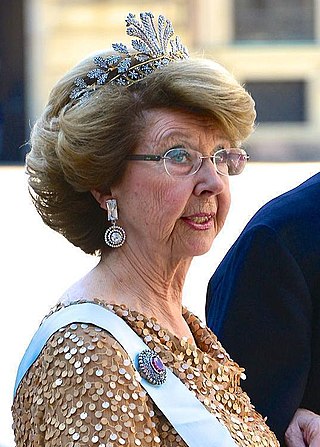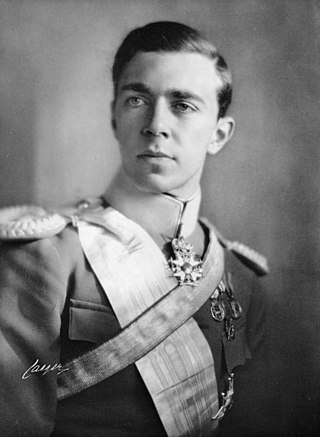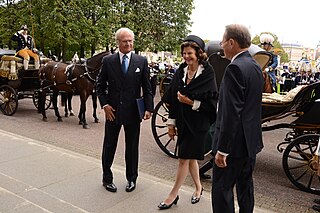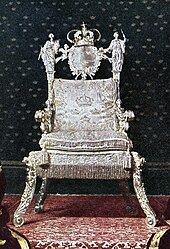
Victoria, Crown Princess of Sweden, Duchess of Västergötland is the heir apparent to the Swedish throne, as the eldest child of King Carl XVI Gustaf. If she ascends to the throne as expected, she would be Sweden’s fourth queen regnant and the first since 1720. Her inheritance is secured by Sweden's 1979 Act of Succession, the first law in Western Europe to adopt royal absolute primogeniture.

Carl XVI Gustaf is King of Sweden.

Ingrid of Sweden was Queen of Denmark from 20 April 1947 to 14 January 1972 as the wife of King Frederik IX.

The monarchy of Sweden is centred on the monarchical head of state of Sweden, by law a constitutional and hereditary monarchy with a parliamentary system. There have been kings in what now is the Kingdom of Sweden for more than a millennium. Originally an elective monarchy, it became a hereditary monarchy in the 16th century during the reign of Gustav Vasa, though virtually all monarchs before that belonged to a limited and small number of political families which are considered to be the royal dynasties of Sweden.

A speech from the throne, or throne speech, is an event in certain monarchies in which the reigning sovereign, or their representative, reads a prepared speech to members of the nation's legislature when a session is opened. The address sets forth the government's priorities for its legislative agenda, for which the cooperation of the legislature is sought. The speech is often accompanied by formal ceremony. It is often held annually, although in some places it may occur more or less frequently, whenever a new session of the legislature is opened.

Prince Carl Philip of Sweden, Duke of Värmland is the only son and the second of three children of King Carl XVI Gustaf and Queen Silvia. As of 2022, Prince Carl Philip is fourth in the line of succession, after his older sister, Crown Princess Victoria, his niece and goddaughter Princess Estelle, and his nephew Prince Oscar. He lives with his wife, Princess Sofia, and three sons, Prince Alexander, Prince Gabriel and Prince Julian in Villa Solbacken in Djurgården, Stockholm.

Prince Bertil, Duke of Halland, was a member of the Swedish royal family. He was the third son of King Gustaf VI Adolf and his first wife, Princess Margaret of Connaught, as well as the uncle of King Carl XVI Gustaf of Sweden. From 1973 to 1979, he was heir presumptive to his nephew Carl XVI Gustaf and the Swedish throne.

Princess Lilian of Sweden, Duchess of Halland, was a British fashion model who became a member of the Swedish royal family through her 1976 marriage to Prince Bertil, Duke of Halland (1912–1997). As such, she was an aunt of King Carl XVI Gustaf of Sweden and Queen Margrethe II of Denmark.

Princess Désirée, Baroness Silfverschiöld is a member of the Swedish royal family. She is the third child of Prince Gustaf Adolf, Duke of Västerbotten, and Princess Sibylla of Saxe-Coburg and Gotha, and an elder sister of King Carl XVI Gustaf.

Princess Christina, Mrs. Magnuson, is a member of the Swedish royal family. She is the fourth child of Prince Gustaf Adolf, Duke of Västerbotten, and Princess Sibylla of Saxe-Coburg and Gotha, and the youngest of the four older sisters of King Carl XVI Gustaf. She generally uses the name Christina Magnuson.

A throne room or throne hall is the room, often rather a hall, in the official residence of the crown, either a palace or a fortified castle, where the throne of a senior figure is set up with elaborate pomp—usually raised, often with steps, and under a canopy, both of which are part of the original notion of the Greek word thronos.

Princess Sibylla of Saxe-Coburg and Gotha was a member of the Swedish royal family and the mother of the current king of Sweden, Carl XVI Gustaf.

Prince Daniel, Duke of Västergötland, is a member of the Swedish royal family by marriage to Victoria, Crown Princess of Sweden making Daniel the likely next consort of Sweden. Prior to his marriage to the heir apparent to the Swedish throne, he was a personal trainer and gym owner and ran a company called Balance Training with three gyms in central Stockholm.

Prince Gustaf Adolf, Duke of Västerbotten was a Swedish prince who for most of his life was second in the line of succession to the Swedish throne. He was the eldest son of Gustaf VI Adolf, who was crown prince for most of his son's life and ascended the Swedish throne three years after his son's death. The current king, Carl XVI Gustaf, is Prince Gustaf Adolf's son. The prince was killed on 26 January 1947 in an airplane crash at Kastrup Airport, Copenhagen, Denmark.

Count Magnus Gabriel De la Gardie was a Swedish statesman and military man. He became a member of the Swedish Privy Council in 1647 and came to be the holder of three of the five offices counted as the Great Officers of the Realm, namely Lord High Treasurer, Lord High Chancellor and Lord High Steward. He also served as Governor-General in the Swedish dominion of Livonia.

Princess Estelle of Sweden, Duchess of Östergötland is a member of the Swedish royal family. She is the elder child of Crown Princess Victoria and Prince Daniel, Duke of Västergötland. She is the eldest grandchild of King Carl XVI Gustaf, and is second in line of succession to the Swedish throne, after her mother.

Several Swedish coronation robes from the 16th to the 19th century are preserved at The Royal Armoury in Stockholm, Sweden. The youngest one, Oscar II's coronation robe from 1873, is in the Treasury at Stockholm Palace.

The Golden Jubilee of Carl XVI Gustaf was celebrated in 2023 in the Kingdom of Sweden, to mark the 50th anniversary of the accession of King Carl XVI Gustaf on 15 September 1973. He is the first Swedish monarch to celebrate a Golden Jubilee. The 500th anniversary of Sweden's regained independence, through the election of King Gustav I, was also marked during the Jubilee year.

The Opening of the Riksdag Session is an annual ceremony in the Kingdom of Sweden to mark the start of a new parliamentary year for the Swedish Riksdag. The current ceremony was first held in 1975, replacing an older ceremony known as the Solemn Opening of the Riksdag that had been held since the 17th century. It is held every year in September. During the ceremony the monarch declares the new session open and the Prime Minister makes a speech outlining the government’s priorities for the upcoming year.



















